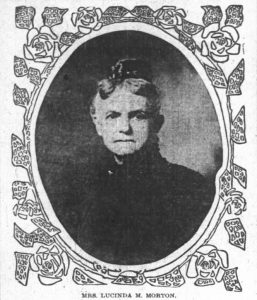
Photo info ...
(May 16, 1825-July 28, 1907). Born in Centerville, Indiana, Lucinda Maria Burbank Morton spent her early life as the well-educated daughter of successful local merchants Isaac and Mary Elizabeth Troxell Burbank. On May 15, 1845, Lucinda Burbank married in her childhood home. They had five children, though two died before the age of two.
Within the first decade and a half of their wedding, tensions about slavery escalated throughout the United States. During those years Burbank Morton managed the household, while her husband first launched his career as an attorney and later pursued his ambitions in Republican Party politics. As abolitionists, the Mortons proved strong supporters of Abraham Lincoln, the Republican candidate for president in 1860. Burbank Morton urged women in Indiana to implore their husbands to vote for Lincoln based on his platform promise to prohibit the expansion of slavery in the Western territories. On October 9, 1860, just a month before Lincoln’s presidential victory, Oliver Morton won election as Lieutenant Governor of Indiana. In January 1861, Morton stepped in as governor of Indiana when incumbent governor Henry S. Lane left office to serve as a US Senator. In April 1861, Confederate troops fired upon Fort Sumter, marking the beginning of the American .
In response to Lincoln’s call for aid, Governor Morton assigned Adjutant General to establish , a base for enlisting and training Union soldiers at the previous site of the . In 1862, Camp Morton was converted to a prisoner-of-war (POW) camp (see ) because of its central location in relation to the war waging across the American South.
Lucinda Burbank Morton saw the opening of the POW camp as an opportunity to showcase the humanity of the Hoosier state. Despite the prisoners’ allegiance to the South and to an ideology she did not support, she believed their comfort and basic needs should be provided for. Burbank Morton organized provisions for the camp and managed the operations thereof. She headed the Ladies Patriotic Association (LPA) to act as a governing body providing sustenance to Camp Morton’s prisoners.
Politically and socially prominent women of Indiana’s high society composed the LPA. Burbank Morton personally recruited many of the members. The Governor’s Mansion (see ) often served as the LPA’s base of operations where the women collected donations and worked on handicrafts based on the needs of the camp. At one meeting, the women sewed and knitted over $200 worth of flannel hats, scarves, and mittens for Confederate prisoners in preparation for the harsh Indiana winter ahead. In 1863, as spring transitioned to summer, an outbreak of measles plagued the camp. Burbank Morton and the LPA women replaced infected blankets, pillows, and towels and collected donations of salt, beer, candles, soap, and dried fruits for the prisoners.
Inspired by his wife’s endeavors and in correlation with the national movement for relief efforts, Governor Morton established the Indiana Sanitary Commission (ISC) in 1862. The ISC provided needed goods and services, including wartime hospitals, to Union troops throughout their service during the conflict. Burbank Morton’s diligent support of wartime efforts and compassion toward combatants of both sides changed the lives of many Union and Confederate troops.
Morton spent the years after the Civil War traveling the country with her husband, whose paralysis of the lower limbs left him wheelchair bound. Oliver Morton suffered his first stroke in 1864, and then a more debilitating attack while at a political event in Oregon in 1877. Lucinda Morton took a special car from Indianapolis to Oregon to pick up her husband, who died soon afterward in November 1877.
Following Oliver Morton’s death, Lucinda Morton traveled and remained active with personal and civic interests. She followed her son Oliver to Oxford, England, in the 1890s, where she met a number of Europe’s cultured elite. In September 1902, she presented a bust of her husband to the Oliver Morton No. 29 at 21st Street and College Avenue.
With her health failing in 1907, Morton was determined to live to see the unveiling of a statue of her husband, being built outside the Indiana to honor his Civil War contributions. She helped the planning commission with all work connected to the monument’s construction, including the design and the inscription on the relief panels. Her last public appearance came at the dedication ceremony of the Lawton Memorial at the Marion County Courthouse (see ) on May 30, 1907, attended by President Theodore Roosevelt. Due to frailty, Lucinda Morton could not attend the dedication ceremony of the Morton Monument on July 23, 1907. However, her eight-year-old grandson Oliver Perry Throck Morton unveiled the monument after Governor Frank Hanly’s dedication speech. Lucinda Morton died at the home she designed at 616 E. 21st Street, five days after the unveiling of the Morton Monument.
FURTHER READING
- Lafever, Carolyn. She Never Failed Me: Lucinda Burbank Morton: Indiana’s first Lady of the Civil War. Greensburg, IN: Winter’s Publishing, 2024. https://search.worldcat.org/title/1441734646.
- The author adapted this EOI entry from their original article:
- McKown, Addy. The Forgotten Women Who Saved the Union: Lucinda Burbank Morton and the Establishment of the U.S. Sanitary Commission in Indiana. Indianapolis: Indiana Historical Bureau, 2018. https://www.in.gov/history/files/Indiana-Sanitary-Commission-Final-Paper-McKown.pdf.
CITE THIS ENTRY
APA:
McKown, A. (2025). Lucinda Burbank Morton. Encyclopedia of Indianapolis. Retrieved Dec 14, 2025, from https://indyencyclopedia.org/lucinda-burbank-morton/.
MLA:
McKown, Addison. “Lucinda Burbank Morton.” Encyclopedia of Indianapolis, 2025, https://indyencyclopedia.org/lucinda-burbank-morton/. Accessed 14 Dec 2025.
Chicago:
McKown, Addison. “Lucinda Burbank Morton.” Encyclopedia of Indianapolis, 2025. Accessed Dec 14, 2025. https://indyencyclopedia.org/lucinda-burbank-morton/.

Help improve this entry
Contribute information, offer corrections, suggest images.
You can also recommend new entries related to this topic.